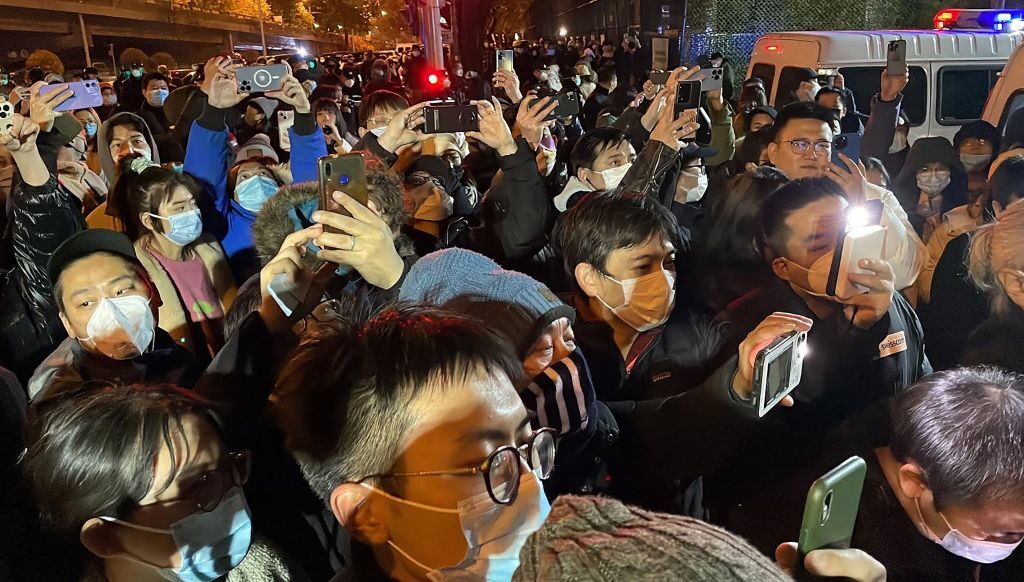The Chinese state propaganda newspaper Global Times announced on Thursday that scientists at Wuhan University had concluded that the omicron variant of Chinese coronavirus presented a “weaker ability to cause diseases” compared to previous iterations of the pathogen.
The study is the first time the Communist Party acknowledges publicly in media accessible to the general Chinese public the overwhelming evidence that the omicron variant of coronavirus is causing significantly fewer instances of severe disease, hospitalization, and death around the world.
Scientists in the free world, including experts with the World Health Organization, had begun to document a drop in severe disease caused by this variant, first sequenced in South Africa late last year but likely originating in Europe, in late 2021.
The Communist Party disregarded expert analysis suggesting that the omicron variant caused less severe disease for much of this year, prompting condemnation from the W.H.O. and other observers who strongly discouraged China’s ongoing use of brutal lockdown policies and internment of thousands in quarantine camps to prevent the spread of disease. The sudden change in Beijing’s attitude toward the variant follows months of increasingly violent protests against mass lockdowns, quarantining, and other human rights violations that culminated in giant protests erupting in the country’s largest cities last weekend.
Authorities have not directly acknowledged the protests but complained of foreign “hostile forces” organizing acts of “sabotage” nationwide and mobilized the nation’s massive security apparatus to track down and disappear protesters.

A nucleic acid testing station is closed as the government signals a possible relaxing of the countrys Covid-19 coronavirus restrictions in Beijing on December 2, 2022. (JADE GAO/AFP via Getty Images)
The Global Times cited a Wuhan University researcher, Lan Ke, as saying that the omicron variant “has weaker ability to cause diseases combined with a lower virulence.”
“Pathogenicity and virulence of coronavirus variants are the key problems that Chinese scientists have been focused on. Recently a research team from the State Key Laboratory of Virology in Wuhan University conducted an experiment that shows that the pathogenicity of Omicron had dramatically decreased,” the propaganda newspaper concluded.
“This reminds us not to panic about Omicron, and for ordinary people, the damage caused by coronavirus has markedly diminished compared to the original strain,” the Global Times advised, concluding, “Compared with the original strain of the coronavirus and previous variants such as Delta and Beta, infection by Omicron causes the lowest reduction in body weight and the lowest mortality rate.”
The Global Times conclusions echo what global public health experts had concluded a year prior. Scientists in South Africa were the first to isolate and identify omicron as a new variant of the Chinese coronavirus in November 2021, but subsequent studies suggested that the virus was present in multiple European countries before South African scientists discovered it. The administration of leftist American President Joe Biden banned South African travelers from the United States anyway, however, while allowing Europeans, causing a diplomatic crisis.
In late November 2021, South African Health Minister Joe Phaahla assured the world there was “absolutely no need to panic” over the omicron variant, as trained scientists were on hand to evaluate its potential effects and no alarming information had surfaced. Phaahla discouraged Biden-style travel bans, calling them “draconian.” South African scientists later found in a study that hospitalizations dropped around 80 percent with the emergence of omicron.
W.H.O. Director-General Tedros Adhanom Ghebreyesus agreed a little more than a week later.
“Emerging data from South Africa suggests increased risk of reinfection with omicron,” Tedros said in early December. “There is also some evidence that omicron causes milder disease than delta.”

Police officers stand guard during a protest in Beijing, China, on early Monday, Nov 28, 2022. Protests against Covid restrictions spread across China as citizens took to the streets and university campuses, venting their anger and their frustrations on local officials and the Communist Party. (Bloomberg)
Delta was the dominant coronavirus variant, originating in India, prior to the emergence of omicron.
In its global report that week, the W.H.O. published evidence of significantly fewer hospitalizations tied to omicron than delta.
“Data which looked at hospitalizations across South Africa between 14 November and 4 December found that ICU occupancy was only 6.3 percent,” the report read, “which is very low compared with the same period when the country was facing the peak linked to the Delta variant in July.”
By January, the W.H.O.’s reports were tallying a dramatic rise in coronavirus cases, fueled by omicron, but no significant changes in deaths, indicating fewer severe cases.
Last month, Tedros revealed at a press conference that the W.H.O. had observed a 90-percent drop in documented coronavirus deaths between February and November 2022.
In the United States, top public health celebrity Anthony Fauci agreed with the W.H.O.’s observations on omicron in late December.
“With omicron, if you have a larger number of infections — and as the data that I presented here indicate that there is — it looks like a significant lessening of severity compared to others,” Fauci said.
The U.S. Centers for Disease Control (CDC) revealed in a study in January that omicron appeared to be about 91-percent less fatal than delta.
“During a period with mixed Delta and Omicron variant circulation, SARS-CoV-2 infections with presumed Omicron variant infection were associated with substantially reduced risk of severe clinical endpoints and shorter durations of hospital stay,” the study found.
Rising awareness in China that the rest of the world had largely returned to normal – which mass house arrest, starvation, and deprivation of basic medical care remained the norm in their country – has resulted in growing numbers of protests throughout the country. Initially, protests began surfacing as isolated incidents, particularly as confrontations with public health officials in cities like Shanghai, which suffered a brutal lockdown in spring 2021, and East Turkistan, the occupied Uyghur region that remains partially in lockdown to this day. Individual protesters also made their mark, most prominently a man later identified as Peng Lifa who hung two giant banners condemning lockdowns, communism, and dictator Xi Jinping personally on one of Beijing’s most trafficked bridges, the Sitong Bridge, during the prestigious Communist Party Congress in October.

Protesters gather along a street during a rally for the victims of a deadly fire as well as a protest against China’s harsh Covid-19 restrictions in Beijing on November 28, 2022. (MICHAEL ZHANG/AFP via Getty Images)
By November, the NGO Freedom House described protests in previously subdued China as a “daily” event.
“Not only is dissent in China frequent, it’s also widespread. Since June, people have protested in nearly every province and directly administered city,” Freedom House detailed. “Moreover, even as authorities make every effort to prevent protestors from connecting, we found many instances where people manage to form decentralized movements that increase the impact of their dissent.”
The Communist Party has yet to weaken lockdowns or abandon its repressive “zero-Covid” policy. It has also not openly acknowledged the protests, using outlets like the Global Times to condemn unspecified “criminal acts disturbing social order.”

COMMENTS
Please let us know if you're having issues with commenting.